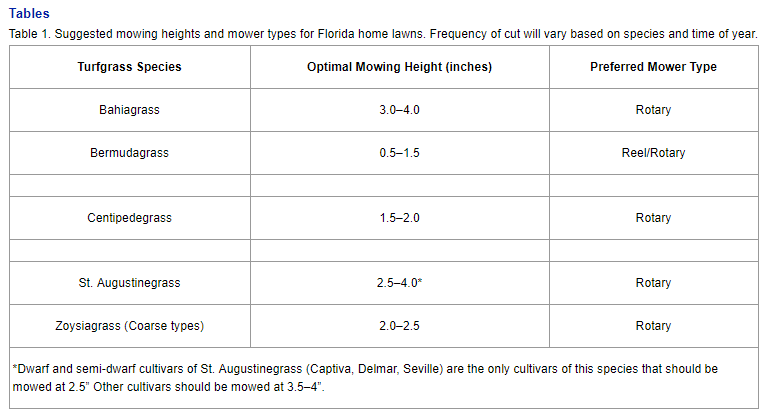Northwest Florida has experienced an enormous amount of rain this summer. The western panhandle has received over 29 inches of rain since the beginning of May according to the Florida Automated Weather Network station at the West Florida Research and Education Center in Jay, Florida. That is 44% of average annual rainfall in less than two months. All of this rain has probably thrown off the normal lawn mowing routine. It is hard to get out and mow the lawn when its pouring buckets or the lawn resembles a swamp. With all of this in mind, there are a couple of mowing pointers that would be useful to implement to address the out of control lawn growth and the challenges posed by not being able to stick to normal mowing schedule.
- Always attempt to mow at the IFAS recommended height for your species of turfgrass. The recommended heights are determined by how quickly the species grow in our climate. The chart below shows the best heights at which to mow your lawn. The fine textured zoysiagrasses are not listed but should be mowed at 0.5 to 1.5 inches. Check the lawn mowers mowing height by measuring the distance from the ground to the bottom of the mowing deck on a flat surface.

- When you do get out to mow, never remove more than 1/3 of the leaf blade. If you cut to short you will “scalp” the turf and cause a brown look on the lawn. This can be damaging to the turf and allow for weeds to get established by exposing the soil to the sunlight. What is taking place more in northwest Florida is not mowing frequently enough and cutting off excess growth due to the rain. This also can cause scalping so it is very important to mow frequently enough to only remove 1/3 of the leaf blade.

Other practices such as keeping your mower blade sharp, mowing in different directions, and leaving clippings on the ground will help keep a healthy Florida lawn. Please see more information about mowing correctly in Florida in the University of Florida/IFAS Extension publication: Mowing Your Florida Lawn
 0
0
